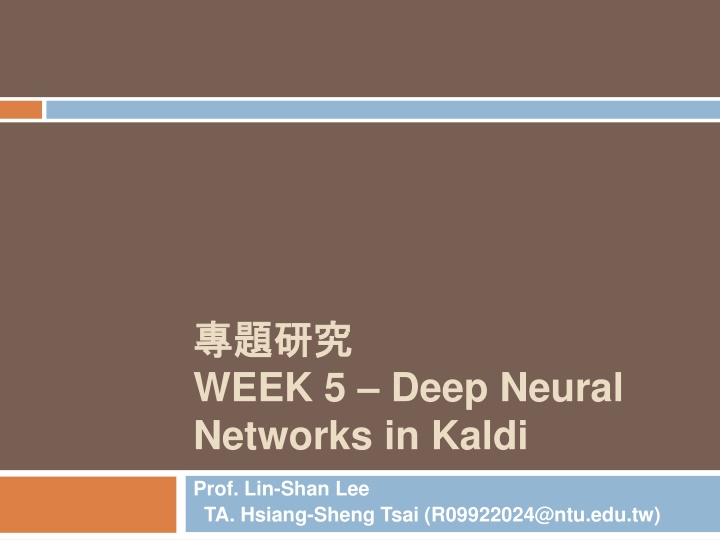
Deep Neural Networks Training in Kaldi Framework
Learn about deep neural networks (DNN) for acoustic modeling in Kaldi, including topics such as linear operations, training processes, loss analysis, and more. Explore homework scripts, download files, and tuning of neural network model parameters. Get hands-on experience in executing commands and modifying training parameters to enhance DNN performance.
Download Presentation

Please find below an Image/Link to download the presentation.
The content on the website is provided AS IS for your information and personal use only. It may not be sold, licensed, or shared on other websites without obtaining consent from the author. If you encounter any issues during the download, it is possible that the publisher has removed the file from their server.
You are allowed to download the files provided on this website for personal or commercial use, subject to the condition that they are used lawfully. All files are the property of their respective owners.
The content on the website is provided AS IS for your information and personal use only. It may not be sold, licensed, or shared on other websites without obtaining consent from the author.
E N D
Presentation Transcript
WEEK 5 Deep Neural Networks in Kaldi Prof. Lin-Shan Lee TA. Hsiang-Sheng Tsai (R09922024@ntu.edu.tw)
Outline Neural Network Homework DNN Training Contact TAs
Neural Network Linear operation Multiplication Addition Convolution Activation function Sigmoid ReLU Tanh Complex functions can be achieved by combination of lots of simple non-linearity functions.
Neural Network Training Loss Steps
DNN in Acoustic Modeling DNN as triphone state classifier Input: acoustic feature (e.g. MFCC frames) Output: probability of each state Hybrid system DNN is only for computing posterior of states State transitions remain unchanged
GMM vs DNN Using GMM: Using DNN: p(s=1) = 0.3 p(s=2) = 0.1 p(s=3) = 0.6 MFCC DNN
Homework Scripts 08.mlp.train.sh 09.mlp.decode.sh Reading DSP CH9 Speech Recognition Updates
Download Files Login to workstation ssh 140.112.21.80 (port 22) Copy the file into your own directory cp /share/week5.tar.gz . Process files with the following command tar zxvf week5.tar.gz cp setup.sh /proj1.ASTMIC.subset cp 08.mlp.train.sh /proj1.ASTMIC.subset/script cp 09.mlp.decode.sh /proj1.ASTMIC.subset/script cp align_dev.sh /proj1.ASTMIC.subset/script
TODO (1/3) Step 1: Execute the following command (baseline): bash setup.sh script/08.mlp.train.sh script/09.mlp.decode.sh Step 2.1: Tune the NN model parameter in script/08.mlp.train.sh depth num_hidden minibatch_size
TODO (2/3) Step 2.2: Modify the training parameters in script/08.mlp.train.sh learning rate Step 2.3: Tune the feature context parameter context
TODO (3/3) Step 3: Adjust acoustic weights in 09.mlp.decode.sh acoustic weight Repeat Step 2 and Step 3 with different hyperparameters to obtain the best accuracy. According to your results, what did you observe? How do hyperparameters effect the result?
Contact TAs Should you have any question or need help, Refer to Kaldi documentation. Post your question on FB group. Send email to r09922024@ntu.edu.tw . Don t forget to use [SpeechProject] as the subject line prefix if you send the email to TA.
